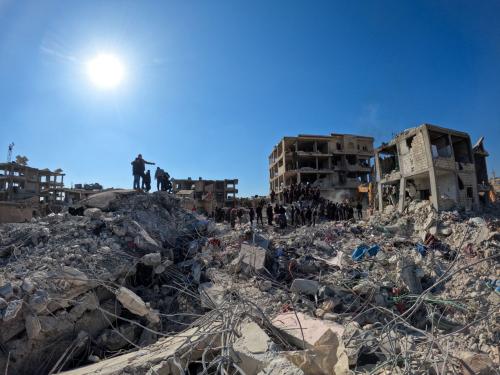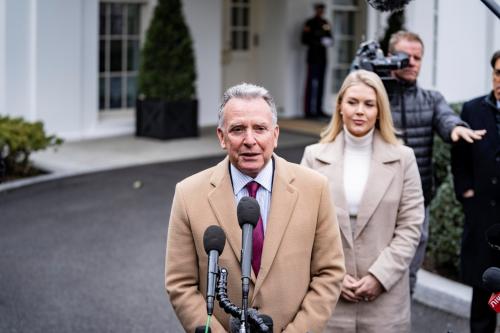In a recent two-part post, Martin Indyk argued that the United States has only two highly imperfect options for dealing with the current disorder in the Middle East: a “condominium” with Iran, or rebuilding a coalition of regional “status-quo” actors including major Sunni states and Israel. He concludes that Iran’s regional orientation is too determinedly destabilizing to make it a viable partner. So America must overcome its inward focus and a re-forge an alliance with the Sunni Arab states and Israel to bring order to the Middle East.
Martin is half-right. The Iran option is obviously flawed for the reasons he provides; but his alternative approach is equally unworkable. The analysis that leads Martin to endorse a “Back to the Future” approach misunderstands why the region has become so disordered and how contentious our putative partners are amongst themselves.
The regional dysfunctions that produced today’s chaotic violence have the governments of many U.S. allies so off-balance that they are, for now, creating problems just as much as they might help solve them. Unless and until the region’s most influential governments can address the underlying causes of disorder—those that lie within their societies—a tighter U.S. alliance with their governments will only make the situation worse.
It’s worse than you think, boss
The Middle East today is indeed chaotic. That disorder stems, not from U.S. policy failures as Martin suggests, but rather from long-simmering problems that undermined state institutions and provoked widespread discontent among youthful, more mobilized populations. The parts of the region that are most disordered today—Libya and Syria—are those where leaders, having rejected reforms and provoked popular uprisings, then sought to repress their angry citizens through overwhelming force. As the state turned against its own citizens, and as institutions of basic governance and community order failed, sectarian militias, terrorism, and civil war filled the void.
The terrible choices of these terrible leaders, more than anything else, created the openings that al Qaeda, ISIS, and sectarian killers across the region now exploit. These groups are symptoms of the Middle East’s fundamental disorder—not the cause and not the disease. Where leaders have basic legitimacy to rule, and where state institutions provide basic functions, terrorism will be a fringe phenomenon rather than an existential threat.
Perhaps a more active American policy could have reduced the severity of the state failure and civil wars that emerged from Qaddafi and Assad’s poor decisions. But even a more engaged America cannot restore order without strong regional allies that share with it a clear view of the order they collectively seek to impose. Unfortunately, such allies don’t exist.
A house divided against itself cannot form an alliance
There is, as Martin suggests, a regional great game underway—but it is far more complex than he describes. With the region’s old order in ruins, revolutionary Iran, conservative Saudi Arabia, capricious Qatar, and neo-Ottoman Turkey are all revisionist powers, each seeking to shape the region to fit their own interests and each supporting local proxies they think can help them to establish dominance. Their struggles rage across the region—Iraq, Syria, Yemen, Libya, Lebanon, and Bahrain all manifest these proxy battles.
The Sunni-Shia conflict that Martin focuses on is but one of three that today roil the region—and that’s before we even get to the Arab-Israeli conflict. Another is the argument, championed by Egypt and the United Arab Emirates on one side and Qatar and Turkey on the other, over whether the region’s emergent order has a place for political Islam. This argument is viewed as existential on both sides, and has become so bitter that it is fueling the Libyan civil war, impeding cooperation on Iraq and Syria and threatening the unity of the Gulf Cooperation Council. The third conflict, of course, is that between the jihadi murderers of ISIS and al Qaeda and those who love life; the Arab states are all on one side in this conflict, but they disagree on how best to fight it.
In the contexts of these multiple conflicts, the putative partners for American policy are so disoriented by the collapse of the region they knew, so fearful of the forces that collapse has unleashed, and so mistrustful of one another’s motives, that collective action is almost impossible to achieve. Alliances of convenience, like that between Egypt and Israel to choke Hamas last summer, quickly break down as deeper differences emerge—today, Egypt wants Hamas destroyed, while Israel prefers a weakened Hamas to any likely successor.
They demonstrate their disagreements, not just with diplomatic vinegar, but with support for local actors that work at cross-purposes, exacerbating the region’s civil wars and further undermining any hope of stability. All these fractious frenemies can agree on, seemingly, is that the region’s mess is somebody else’s fault, and that things would get much better if only the United States would go along with whatever their preferences happen to be. It is on such treacherous ground that Martin argues Washington should build “pillars of stability.” This would constitute architectural malpractice.
Given the divides and dysfunctions within the region, then, neither of the options Martin proposes for U.S. strategy is viable.
The only logical American strategy for the current moment is a hedging strategy: selectively engage on key issues that threaten U.S. security, work in partnership with effective local actors on specific issues of common importance, and avoid efforts by regional actors to draw the United States into their internecine arguments. Over the longer term, the United States needs to at least try to bolster the beleaguered few within Arab societies who are still working for a future of tolerance, coexistence, and pluralism. They are the ones who can ultimately address the root causes of regional disorder and nudge America’s partners and adversaries alike toward more effective and accountable forms of governance. This is not an easy task under any circumstances, but an uncritical alliance with the unhappy family of Sunni states would push in precisely the opposite direction.
The Brookings Institution is committed to quality, independence, and impact.
We are supported by a diverse array of funders. In line with our values and policies, each Brookings publication represents the sole views of its author(s).


Commentary
With friends like these: America’s allies in the Middle East create as many problems as they solve
March 2, 2015